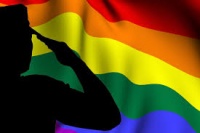Difference between revisions of "Transgender Military Personnel"
| Line 1: | Line 1: | ||
[[File:lgbtqmilitary.jpg|200px|thumb|left|LGBTQ Military]] | [[File:lgbtqmilitary.jpg|200px|thumb|left|LGBTQ Military]] | ||
| − | Transgender rights and issues are a prominent part of the LGBTQ human rights movement. This is particularly so in military services around the world. Most countries continue to have an outright ban on transgender military personnel. Nineteen nations, including Australia, Canada, Israel, the United | + | Transgender rights and issues are a prominent part of the LGBTQ human rights movement. This is particularly so in military services around the world. Most countries continue to have an outright ban on transgender military personnel. Nineteen nations, including Australia, Canada, Israel, the United States and Great Britain, allow military service by transgender individuals. The Netherlands was the first country in the world (1974) to permit transgender individuals to openly serve in the military. |
Despite the ban in other countries, an increasing number of transgender military personnel are choosing to open up. In 2014, the first international conference on the subject was held and received significant global media coverage. The conference, title ‘Perspectives on Transgender Military Service from Around the Globe’, was held in Washington D.C. and hosted by the American Civil Liberties Union. | Despite the ban in other countries, an increasing number of transgender military personnel are choosing to open up. In 2014, the first international conference on the subject was held and received significant global media coverage. The conference, title ‘Perspectives on Transgender Military Service from Around the Globe’, was held in Washington D.C. and hosted by the American Civil Liberties Union. | ||
| − | The United States is the most recent country to | + | The United States is the most recent country to have relaxed its regulations on transgender military personnel, making it harder to remove such troops from service by assigning responsibility to a senior civilian official. This follows from the military's dismantlement of the 'don't ask don't tell' policy. The first out transgender individual to serve in the U.S. military was [[Shane Ortega]], a Sergeant in the army. |
According to a Williams Institute 2014 study, an estimated 15,500 transgender individuals currently serve in the U.S. military with 60% being male and 40% female. Nevertheless, an outright ban remains in place. | According to a Williams Institute 2014 study, an estimated 15,500 transgender individuals currently serve in the U.S. military with 60% being male and 40% female. Nevertheless, an outright ban remains in place. | ||
| Line 26: | Line 26: | ||
* [[Natalie Murray]], Canada | * [[Natalie Murray]], Canada | ||
* [[Anwen Muston]], Great Britain | * [[Anwen Muston]], Great Britain | ||
| + | * [[Shane Ortega]], United States | ||
* [[Caroline R. Paige]], Great Britain | * [[Caroline R. Paige]], Great Britain | ||
* [[Jennifer Pritzker]], United States | * [[Jennifer Pritzker]], United States | ||
Revision as of 19:20, 27 July 2017
Transgender rights and issues are a prominent part of the LGBTQ human rights movement. This is particularly so in military services around the world. Most countries continue to have an outright ban on transgender military personnel. Nineteen nations, including Australia, Canada, Israel, the United States and Great Britain, allow military service by transgender individuals. The Netherlands was the first country in the world (1974) to permit transgender individuals to openly serve in the military.
Despite the ban in other countries, an increasing number of transgender military personnel are choosing to open up. In 2014, the first international conference on the subject was held and received significant global media coverage. The conference, title ‘Perspectives on Transgender Military Service from Around the Globe’, was held in Washington D.C. and hosted by the American Civil Liberties Union.
The United States is the most recent country to have relaxed its regulations on transgender military personnel, making it harder to remove such troops from service by assigning responsibility to a senior civilian official. This follows from the military's dismantlement of the 'don't ask don't tell' policy. The first out transgender individual to serve in the U.S. military was Shane Ortega, a Sergeant in the army.
According to a Williams Institute 2014 study, an estimated 15,500 transgender individuals currently serve in the U.S. military with 60% being male and 40% female. Nevertheless, an outright ban remains in place.
The issues for serving transgender military personnel include social issues (where to sleep and shower), hormone treatment plans and other medical assistance, respect and civility with fellow members, how they are addressed, what uniform to wear, and promotion opportunities.
There remains a distinct disconnect between acceptance and policy on the issue today. There is no compelling medical reason for the banning of transgender individuals from serving given current modern medical procedures. Rather, any ban is itself a damaging and unfair policy. Allowing transgender individuals to serve would actually reduce incidences of gender harassment, assaults, and suicides.
We have identified a number of high-profile transgender members of the military from around the world. Simply click on their names to read their fascinating biographies.
- Kristin Beck, United States
- Jan Hamilton, Great Britain (now known as Abigail Austen)
- Donna Harding, Australia
- Ayla Holdom, Great Britain
- Catherine Humphries, Australia
- Lucy Jordan, New Zealand
- Alexandra Larsson, Sweden
- Chelsea Manning, United States
- Cate McGregor, Australia
- Natalie Murray, Canada
- Anwen Muston, Great Britain
- Shane Ortega, United States
- Caroline R. Paige, Great Britain
- Jennifer Pritzker, United States
- Lieutenant Shachar, Israel
- Shawn Skelly, United States
- Evan Young, United States
- Sarah Weston, United States
- Hannah Winterbourne, Great Britain
- Aaron Wixson, United States
See Also
Further Reading/Research
- http://williamsinstitute.law.ucla.edu/wp-content/uploads/Transgender-Military-Service-May-2014.pdf
- http://www.washingtonpost.com/politics/transgender-military-members-are-in-a-precarious-position/2014/10/27/38204fd6-5870-11e4-b812-38518ae74c67_story.html
- https://www.aclu.org/perspectives-transgender-military-service-around-globe

